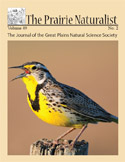Great Plains Natural Science Society

The Prairie Naturalist
Date of this Version
6-2011
Document Type
Article
Citation
The Prairie Naturalist 43(1/2):64–65; 2011
Abstract
Accidental deaths of bats by entanglement on plants and barbed wire are common (McNicholl 1988, Norquay et al. 2010). It has been hypothesized these incidents involve miscalculations by bats on how close they fly to plants or barbed wire or when chasing insects highly concentrated around vegetation (Norquay et al. 2010). Once the bats hit the plants or barbed wire, they become entangled and or impaled while struggling to free themselves. The earliest reports involved little brown bats (Myotis lucifugus) and unidentified bats entangled on burdock, Arctium sp. (Lyon 1925, Little 1925). Additional reports of bats becoming entangled in plants or on barbed wired have included the red bat, Lasiurus borealis (Johnson 1933), California leaf-nosed bat, Macrotus californicus (Stager 1943) and a hoary bat. L. cinereus (Iwen 1958, Hibbard 1963, Long 1964). Other reports include the Indiana bat, M. sodalis (DeBlase and Cope 1967), big brown bat, Eptesicus fuscus (Walley et al. 1969), little brown bat (Verts 1988), and the long-eared bat, M. evotis (Hendricks et al. 2003). Additionally, the California leaf-nosed bat has been documented being impaled on the needles of a potted cactus on a porch as it flew between the cactus and the wall of the house (Gronau 2006). Norquay et al. (2010) reported that two silver-haired bats (Lasionycteris noctivagans) were found alive on burdock, nursed back to health, and then released. Our report is the second reported death of bats resulting from entanglement on cactus and the first to report multiple bats entangled on one cactus over a two year period.
Included in
Biodiversity Commons, Botany Commons, Ecology and Evolutionary Biology Commons, Natural Resources and Conservation Commons, Systems Biology Commons, Weed Science Commons


Comments
Published by the Great Plains Natural Science Society. Used by permission.